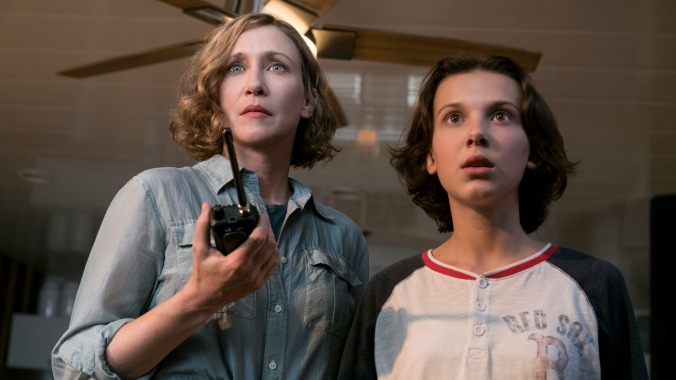The kaiju are cool, but the rest is a mess, in the supersized Godzilla: King Of The Monsters

The Godzilla formula is at once very specific and relatively flexible, allowing filmmakers to put their individual stamp on the familiar story of a giant reptile destroying a city. Previous films in the six-decades-old franchise have offered awe-inspiring spectacle, biting satire, or, most commonly, kid-friendly goofiness. Michael Dougherty, director of the holiday horror movie Krampus, is fixated on the monsters themselves, and proves as much by jamming three kaiju set pieces into the first 45 minutes of Godzilla: King Of The Monsters. The creature design in King Of The Monsters is bespoke—it looks like Godzilla has been hitting the gym between movies—and meticulously detailed, with special attention paid to texture. The monsters are alternately painterly and lifelike, and their movements are expressive enough to convey personality even through the sheets of computer-generated rain that pour down throughout the film’s climax. When they fight each other, or scream in triumph over the smoking ruins of various world capitals, it’s difficult not to fist-pump a little. However, to Dougherty’s presumed disappointment—and to this movie’s ultimate detriment—you can’t just have two hours of kaiju slapping each other around like a gargantuan WWE highlights reel.
In fact, Godzilla: King Of The Monsters is reminiscent of an era when the popularity of pro wrestling was at its height. The film blends bombastic excess and deadpan silliness in a way that recalls late ’90s action films of the Michael Bay/Roland Emmerich school. (Think: a machine-gun wielding grunt muttering, “Oh, shit,” just before a massive CGI explosion sends bodies and helicopters flying in all directions.) Even the decision to make the film’s human bad, Jonah Alan (Charles Dance), an ecoterrorist has an endearing ’90s nostalgia to it. But although it seems as though Will Smith could walk around the corner at any moment, the quippy heavy lifting is performed by Dr. Rick Stanton (Bradley Whitford) and Chief Warrant Officer Barnes (O’Shea Jackson Jr.), with Whitford in the role of the gum-chewing, snarky skeptic and Jackson playing the career soldier who keeps emptying round after round into the monsters, even after it becomes obvious that the big guys can’t even feel it.
Unfortunately for the rest of the cast—like poor Thomas Middleditch, who looks genuinely uncomfortable throughout—it takes a certain sardonic flair to deliver hammy lines in a way that induces knowing laughs instead of derisive ones. And with dramatic actors like Dance, Sally Hawkins (who disappears halfway through with very little fanfare), Zhang Ziyi, and Aisha Hinds rounding out the ensemble cast, the dialogue ends up being unintentionally funny more often than intentionally so. Then there’s Ken Watanabe, who has the gravitas to make anything sound good but whose quest for spiritual communion with the beasts is from another movie altogether. Add in the trading-card aspect of the globe-trotting trips to secret military bases around the world and a self-serious but extremely muddled nuclear/climate change metaphor, and you’ve got a film that is clearly invested in its own mythology but too scattered to decide which direction it wants to take it in.
The least successful flavor in this swirl of them is the family drama, which brings in characters that were not in the previous film, Gareth Edwards’ 2014 Godzilla, though they’re written as if they were. Vera Farmiga stars as Dr. Emma Russell, a brilliant scientist driven to the point of obsession by—what else?—the death of her youngest in Godzilla’s rampage across San Francisco last time around. Dr. Russell is developing a device called ORCA that can communicate with the kaiju through sonar à la whales or dolphins, but her holistic approach is deeply unpopular among the general public, which is mostly in favor of just nuking the “Titans” to hell. Russell has a sadsack ex-husband, Mark (Kyle Chandler), recruited by MONARCH—the series’ monster-investigating intelligence agency—after his ex-wife and their daughter, Madison (Millie Bobby Brown), are kidnapped by the ecoterrorists. For her part, Brown wears the traditional baseball cap of a precocious Godzilla kid, but her performance is more sullen than outright annoying (as Godzilla kids also traditionally tend to be). She’s clearly very used to all of this, so much so that she doesn’t seem to notice 150-foot monsters battling all around her when she’s got her air pods in.
Of a piece with that particular bit of cognitive dissonance is the film’s sense of scale, or lack thereof. The sheer size difference between human and kaiju that was so prominent in Edwards’ Godzilla disappears from King Of The Monsters once the big fights really start cooking, and is never recovered. That’s not to say said fights aren’t cool. The action is pretty legible, all things considered, and the compositions are often beautiful, with a strong element of chiaroscuro. In contrast to the mixed tones, the monsters are coded in straightforward elemental colors: Oversized insect Mothra is born as a glowing blue pupa that hatches into a butterfly whose elegant wings give off puffs of gold glitter, while the pterodactyl Rodan explodes out of a long-dormant Mexican volcano with hard and crispy lava skin and orange magma blood. Some of the set design, particularly MONARCH’s underground headquarters and an ancient underwater temple, is gorgeous as well. It’s just that, in his eagerness to smash together Godzilla and Rodan and Mothra and the three-headed dragon Ghidorah like so many action figures in his personal blockbuster sandbox, Dougherty doesn’t seem to have thought through how it should all fit together. Of course the monsters should be the stars of a Godzilla movie. But until blockbuster filmmaking goes entirely non-narrative, some attention should be paid to the rest of it as well.